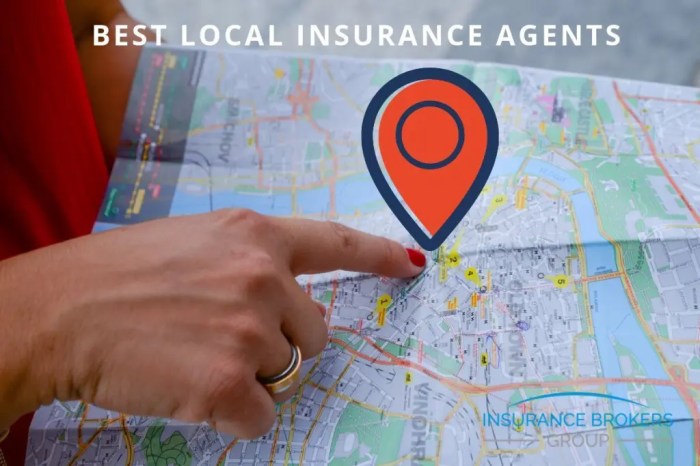High-risk driver insurance brokers near me? Yeah, finding the right insurance when you’ve got a less-than-perfect driving record can feel like navigating a minefield. But don’t sweat it – this isn’t some impossible quest. We’re breaking down how to find those brokers who specialize in helping high-risk drivers like you get the coverage you need, at a price that doesn’t break the bank.
We’ll cover everything from understanding what makes a driver “high-risk” to comparing brokers and navigating the whole insurance process.
This guide will walk you through the steps of finding a local broker, comparing their services and pricing, understanding policy specifics, and even submitting a claim if needed. Think of it as your cheat sheet to getting the best high-risk insurance possible. Let’s get started!
Understanding “High-Risk Driver Insurance”: High-risk Driver Insurance Brokers Near Me
So, you’ve landed in the somewhat less-than-glamorous world of high-risk driver insurance. Don’t worry, it’s not a death sentence for your driving privileges. This type of insurance is simply designed for individuals whose driving records present a higher-than-average risk to insurance companies. Understanding what makes a driver “high-risk” is the first step to navigating this landscape and finding affordable coverage.High-risk drivers are essentially those deemed statistically more likely to be involved in accidents or file insurance claims.
This assessment is based on a combination of factors, all meticulously tracked and analyzed by insurance companies. The goal is not to punish, but to accurately assess risk and price insurance accordingly.
Factors Defining a High-Risk Driver
Several factors contribute to a driver’s classification as high-risk. These include a poor driving record, age (younger and older drivers often fall into this category), location (areas with higher accident rates), and the type of vehicle driven (high-performance cars are often considered riskier). Insurance companies use sophisticated algorithms to weigh these factors, resulting in a final risk assessment.
A history of accidents, traffic violations, or even claims filed by others against you significantly impacts your classification.
Driving Infractions Leading to Higher Premiums
A history of certain driving infractions almost guarantees higher insurance premiums. This isn’t arbitrary; it reflects the statistical correlation between these infractions and increased accident risk. Examples include multiple speeding tickets (especially excessive speeding), driving under the influence (DUI or DWI), reckless driving, hit-and-run accidents, and driving with a suspended or revoked license. The severity and frequency of these infractions directly impact the premium increase.
For instance, a single speeding ticket might result in a minor increase, while multiple DUIs could lead to significantly higher premiums or even denial of coverage from standard insurers.
Insurance Companies Specializing in High-Risk Driver Insurance
Several insurance companies specialize in providing coverage for high-risk drivers. These companies often employ more lenient underwriting standards, accepting applicants that standard insurers might reject. It’s important to remember that these specialized insurers typically charge higher premiums than standard insurers, reflecting the increased risk. Examples of companies that often cater to this market include, but are not limited to, companies like Progressive, Geico, and State Farm (although their specific offerings vary by state and individual risk profiles).
Finding the right company involves comparing quotes and policies from multiple providers to secure the best possible coverage at a manageable price. It’s a good idea to contact an independent insurance agent; they can shop around for you.
Coverage Options for High-Risk vs. Standard Drivers
While the core coverages (liability, collision, comprehensive) remain the same for both high-risk and standard drivers, the availability and cost differ significantly. High-risk drivers may find it more challenging to obtain certain types of coverage, such as uninsured/underinsured motorist coverage at the same level as standard drivers, or they may face higher deductibles and premiums for the same coverage. For example, a standard driver might secure comprehensive coverage with a $500 deductible, while a high-risk driver might only qualify for the same coverage with a $1000 or even $2000 deductible, significantly increasing their out-of-pocket expenses in case of an accident.
Finding high-risk driver insurance brokers near me can be tough, especially if you’re on a budget. To keep your monthly payments down, you might consider leasing a cheaper car; check out this list of Cheapest cars to lease under $300/month to see what fits your needs. Lower monthly payments on your car can help free up some cash to pay for that higher insurance premium, so it’s all about finding the right balance.
Remember to shop around for the best high-risk driver insurance rates!
The key difference boils down to cost and access – high-risk drivers generally pay more for the same or less comprehensive coverage.
Locating Local Brokers
Finding the right high-risk insurance broker can feel like navigating a minefield, but with a strategic approach, you can locate reliable professionals in your area. This section Artikels effective methods for identifying and verifying brokers specializing in high-risk drivers.
A successful search hinges on leveraging online resources and understanding the importance of verification. Remember, not all brokers are created equal, and choosing the right one can significantly impact your insurance premiums and coverage.
Online Search Strategies
Employing specific s is crucial for effective online searches. Instead of simply typing “insurance,” use more targeted phrases like “high-risk driver insurance brokers near me,” “non-standard auto insurance,” or even “SR-22 insurance providers.” Adding your city or zip code refines the results further. Experiment with different combinations to broaden your search and uncover a wider range of options.
Consider using advanced search operators like quotation marks (” “) to find exact matches or the minus sign (-) to exclude irrelevant results. For example, searching “high-risk driver insurance -cheap” would eliminate results primarily focused on low-cost options, which may not adequately address your specific needs.
Commonly Used Websites and Apps
Several online platforms facilitate the search for insurance brokers. These platforms offer varying levels of detail and functionality. Some examples include:
Many insurance comparison websites allow you to input your information and receive quotes from multiple providers. While not all explicitly cater to high-risk drivers, many brokers working with this demographic will be included in their networks. These sites are a good starting point to get a feel for pricing and available options.
Dedicated insurance broker directories often provide more comprehensive information about individual brokers, including their specializations and client reviews. These directories are beneficial in identifying brokers with specific experience in handling high-risk driver cases. Always verify the information provided with independent sources before making a decision.
| Broker Name | Location | Contact Information | Specializations |
|---|---|---|---|
| Example Broker 1 | Anytown, CA | (555) 123-4567 | High-Risk Drivers, DUI, SR-22 |
| Example Broker 2 | Springfield, IL | (555) 987-6543 | High-Risk Drivers, Accidents, Young Drivers |
| Example Broker 3 | Austin, TX | (555) 555-5555 | High-Risk Drivers, Commercial Vehicles, Non-Owner Policies |
Verifying Broker Licensing and Reputation
Before entrusting your insurance needs to any broker, thorough verification is paramount. Check the broker’s license status with your state’s Department of Insurance. This ensures they are legally authorized to operate and sell insurance in your jurisdiction. Online reviews and ratings on platforms like Yelp or Google My Business can offer insights into a broker’s reputation and client experiences.
Look for consistent positive feedback and a track record of addressing client concerns effectively. Contacting the Better Business Bureau (BBB) can also provide additional information about any complaints or unresolved issues. Remember that a broker’s licensing and positive reviews are strong indicators of their credibility and professionalism.
Comparing Broker Services

Choosing the right high-risk insurance broker can significantly impact your premiums and the overall experience. Several factors differentiate brokers, making careful comparison crucial before committing. This section will analyze the services, pricing, and unique features of three hypothetical brokers to illustrate the decision-making process. Remember, these are examples and actual broker offerings may vary.
Broker Service Comparison: Hypothetical Examples
Let’s compare three fictional brokers: “SafeDrive Insurance Brokers,” “Ace High-Risk Auto,” and “Liberty Mutual (Direct).” These represent different business models to highlight the potential advantages and disadvantages of each.
SafeDrive Insurance Brokers is an independent broker, meaning they work with multiple insurance companies to find the best policy for their clients. Ace High-Risk Auto specializes in high-risk drivers and works primarily with a few select insurers. Liberty Mutual (Direct) represents a large national insurer’s direct sales channel, eliminating the intermediary broker.
Pricing Structures and Payment Options
Pricing varies considerably among brokers and depends on several factors including your driving record, age, vehicle, and location. However, we can illustrate general differences in approach.
SafeDrive Insurance Brokers might offer a wider range of premium options due to their access to multiple insurers. They might accept payments through various methods, including credit cards, debit cards, and possibly even financing options depending on the insurer. Ace High-Risk Auto, focusing on a niche market, may have a more standardized pricing structure, possibly with fewer payment choices. Liberty Mutual (Direct) might offer a streamlined online payment system with limited flexibility, but potentially with automatic payment options.
Finding high-risk driver insurance brokers near me can be tough, especially if your credit score needs a boost. Getting a good rate often hinges on your credit, so check out this guide on How to improve credit score before car loan to prep before you shop for insurance. A better score might mean lower premiums from those brokers specializing in high-risk drivers.
Unique Features and Benefits
Each broker might offer unique features to attract clients.
SafeDrive, as an independent broker, could provide personalized service and advocacy with insurance companies, helping navigate complex claims processes. Ace High-Risk Auto might specialize in specific types of high-risk coverage, like SR-22 filings, offering expertise in this area. Liberty Mutual (Direct) might emphasize ease of online management and 24/7 customer service access through their app and website.
Independent Broker vs. Company-Affiliated Agent
The choice between an independent broker and a company-affiliated agent involves trade-offs.
Independent brokers like SafeDrive offer broader choices, potentially securing better rates and coverage options due to their access to multiple insurers. However, they may not offer the same level of brand recognition or potentially streamlined processes as a company-affiliated agent. Company-affiliated agents, like a direct representative of Liberty Mutual, provide brand familiarity and potentially simplified processes. However, their choices are limited to the products and services offered by their company.
Ace High-Risk Auto sits somewhere in between, offering specialized knowledge but potentially limited insurer options.
Policy Considerations for High-Risk Drivers

Securing car insurance as a high-risk driver presents unique challenges. Understanding the specifics of your policy is crucial to avoid unexpected costs and ensure you have adequate coverage. This section will delve into common policy limitations, interpreting your policy document, obtaining SR-22 certificates, and how improving your driving record can impact future premiums.
Common Policy Exclusions and Limitations
High-risk drivers often face restrictions on their insurance coverage. These limitations are designed to mitigate the higher risk associated with their driving history. Companies assess the risk based on factors like accidents, tickets, and the type of vehicle driven. The specific exclusions can vary significantly between insurers and states.
- Higher Premiums: This is the most obvious limitation. Expect to pay substantially more than a driver with a clean record.
- Limited Coverage Options: You might find it difficult to obtain comprehensive or collision coverage, or these options may come with significantly higher deductibles.
- Restricted Vehicle Types: Some insurers might restrict the types of vehicles you can insure, potentially excluding high-performance cars or motorcycles.
- Surcharges and Fees: Expect additional fees and surcharges added to your premium, reflecting the increased risk.
- Cancellation Clause: Policies might include stricter cancellation clauses, meaning that even minor infractions could lead to policy termination.
Interpreting Insurance Policy Documents
Insurance policies can seem daunting, but understanding the key sections is vital. Focus on the declarations page (summarizing your coverage), the definitions section (clarifying terms), and the exclusions section (detailing what isn’t covered).For example, a policy might state that “liability coverage does not extend to injuries sustained while operating a vehicle under the influence of alcohol.” This clearly defines a specific exclusion.
Pay close attention to the language used; ambiguities should be clarified directly with your insurer. Don’t hesitate to ask for clarification on any unclear sections. A good broker can help you navigate this process.
Obtaining an SR-22 Certificate
In many states, high-risk drivers are required to file an SR-22 certificate with the Department of Motor Vehicles (DMV). This certificate verifies that you maintain the minimum required liability insurance. It’s not insurance itself, but proof of insurance.To obtain an SR-22, you’ll need to work with your insurance company. They will file the certificate electronically with the DMV on your behalf.
There is typically a fee associated with this service, added to your premium. Failure to maintain an active SR-22 can lead to license suspension or revocation. The process varies by state, so it’s important to check with your local DMV for specific requirements.
Impact of Driving Record Improvements
Improving your driving record can significantly reduce your insurance premiums over time. After a period of accident-free and violation-free driving, you can request a rate review from your insurer. Many companies offer discounts for safe driving, such as good driver discounts or accident-free discounts.For example, if you’ve gone three years without an accident or ticket, you could be eligible for a substantial discount.
This is why maintaining a clean driving record is so important, not just for legal reasons, but also for significant long-term savings on your car insurance. Keep detailed records of your driving history and any improvements, as this information will be helpful when you request a rate review.
Illustrating the Insurance Process
Navigating the world of high-risk driver insurance can feel overwhelming, but understanding the process makes it much more manageable. This section breaks down the steps involved in getting a quote and filing a claim, along with typical timeframes.Getting a quote from a high-risk insurance broker is straightforward, albeit requiring more information than standard insurance.
Obtaining a High-Risk Insurance Quote
The process typically involves these steps: First, you’ll contact several brokers, either by phone, email, or through their online portals. You’ll then provide them with your driving history, including any accidents, tickets, or DUI convictions. Be completely transparent; omitting information can jeopardize your coverage. The broker will use this information to get quotes from various insurance companies specializing in high-risk drivers.
You’ll receive quotes outlining coverage options and premiums. Review each quote carefully, comparing coverage limits and prices. Finally, select the policy that best suits your needs and budget, and provide the necessary documentation to finalize the purchase.
Submitting a High-Risk Insurance Claim
Following an accident, promptly report the incident to both your broker and the police. Gather as much information as possible, including police reports, witness statements, and photos of the accident scene and vehicle damage. Contact your broker to begin the claims process. They will guide you through the necessary paperwork and provide updates on the claim’s progress.
The insurance company will then investigate the accident, potentially requesting additional information or documentation. Once the investigation is complete, the insurance company will determine liability and the amount of coverage. Remember to be patient; the claim process can take time, especially with high-risk cases.
Typical Timeframes for Applications and Claims, High-risk driver insurance brokers near me
Insurance application processing times vary depending on the complexity of the application and the insurer. Expect to wait anywhere from a few days to several weeks for approval. Factors influencing the processing time include the completeness of your application, the severity of your driving record, and the insurer’s workload. Similarly, claim processing times are variable. A simple claim might be processed within a few weeks, while more complex claims involving significant damage or legal disputes can take months to resolve.
For example, a minor fender bender with clear liability might be resolved quickly, whereas a multi-vehicle accident requiring extensive investigation and legal proceedings could take much longer.
Visual Representation of the Insurance Process
Imagine a three-part diagram. On the left is the driver, represented by a person icon. In the center is the broker, depicted as a house with a symbol for communication (like a speech bubble). On the right is the insurance company, represented by a building icon.Arrows connect the elements. An arrow goes from the driver to the broker, indicating the driver providing information and requesting quotes.
Another arrow goes from the broker to the insurance company, showing the broker submitting the driver’s information and receiving quotes. A third arrow goes from the insurance company back to the broker, indicating the quotes being sent to the broker. A final arrow goes from the broker back to the driver, showing the driver receiving and choosing a policy.
In the case of a claim, an additional arrow would go from the driver to the broker (reporting the accident) and then from the broker to the insurance company, and finally a feedback loop back to the driver from the insurance company regarding claim status and settlement. This diagram clearly illustrates the flow of information and the roles of each party.
Epilogue

So, finding the right insurance as a high-risk driver doesn’t have to be a total nightmare. By doing your research, comparing brokers, and understanding your policy, you can get the coverage you need without getting totally ripped off. Remember, a good broker is your advocate – they’ll help you navigate the complexities of high-risk insurance and find a policy that works for you.
Now go forth and conquer those insurance quotes!